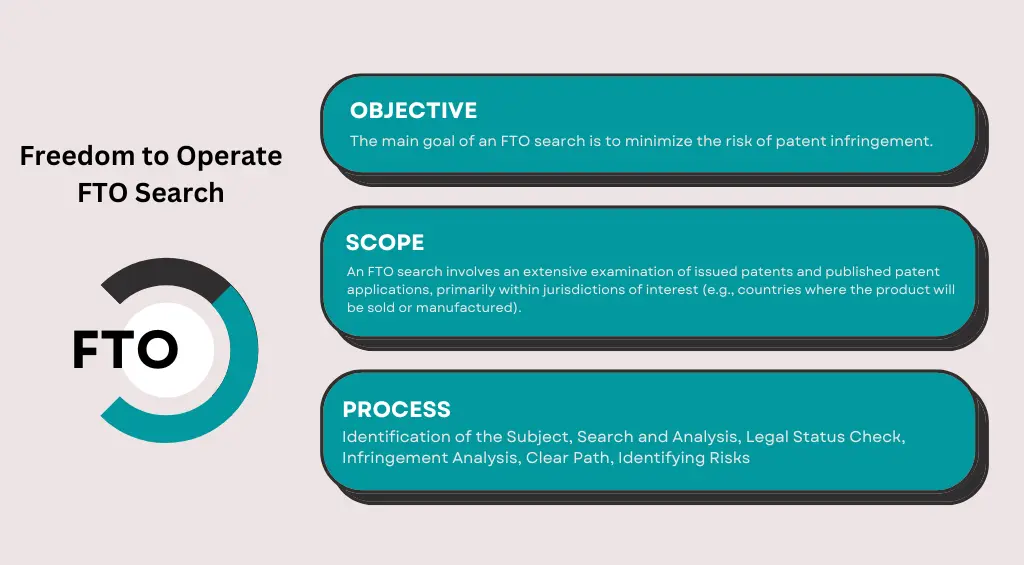Freedom to Operate FTO Search Report Sample: A Freedom to Operate (FTO) search, also known as a Clearance Search or Right to Use search, The purpose of this search is to determine if a particular action, such as launching a new product using a new process or entering a new market, can be done without infringing on the valid Patents of others.
Freedom to Operate FTO Search Report Sample

Here’s a detailed breakdown:
The Objective of FTO Search
The main goal of an FTO search is to minimize the risk of patent infringement. It helps a company or individual understand whether their product, process, or technology might infringe any existing patents or IP rights.
Scope of the FTO Search
An FTO search involves an extensive examination of issued patents and published patent applications, primarily within jurisdictions of interest (e.g., countries where the product will be sold or manufactured).
Process of the FTO Search
Identification of the Subject: This initial step is critical. It involves a detailed definition of the product, process, or technology under consideration. Special attention should be given to identifying all independent features of the product. These features should be separately analyzed as each can potentially infringe different patents. If the product has multiple independent features, focus on all commercially significant aspects, as these are likely to be the most relevant for patent infringement risks. A separate and careful search should be conducted for each of these features to ensure that all possible IP conflicts are identified.
Search and Analysis: Conduct a thorough search for existing patents and patent applications. This step is critical and involves selecting appropriate patent databases. Databases like PatBase, PatSeer, and Orbit are commonly used, each with its own strengths in terms of jurisdictional coverage, search capabilities, and analysis tools. The choice of database should be based on factors like jurisdictional coverage (matching the regions of product launch or manufacture), database update frequency, search functionality, analysis tools, and access to current legal status information.
Legal Status Check: This step is crucial for verifying the enforceability of relevant patents. While patent databases offer initial legal status information, it is highly recommended to cross-check this data with national patent registers such as the USPTO or EPO for the most up-to-date and accurate information. These official registers provide the latest legal status of patents, ensuring a more reliable assessment of potential legal risks.
Infringement Analysis: This critical step involves examining if the subject matter potentially infringes any existing patent claims. Special attention is required when interpreting independent claims, as they are often drafted broadly to encompass a wide range of variations. This broadness means that even if a product or process does not exactly match every feature of a claim, it could still potentially infringe if it falls within the broad scope of the claim. Therefore, a nuanced understanding of patent law and claim interpretation is essential in this phase.
Clear Path: If no potential infringements are found, proceed with caution. However, it’s crucial to recognize that a lack of identified infringements doesn’t guarantee zero risk. Patent applications can take up to 18 months to get published, and commercial databases may not immediately update their data. Therefore, it’s advisable to conduct a “delta search” every 2 to 3 years, especially for products that are crucial to your company. This ongoing vigilance helps in identifying any new patents that may have emerged and pose a risk to your operations.
Identifying Risks: If potential infringements are found, it allows the company to take proactive steps such as redesigning the product, acquiring licenses, or challenging the validity of the potentially infringed patents.
Importance of Freedom to Operate FTO Search Report
Risk Management in FTO Searches:
Preventive Action: An FTO search serves as a proactive measure. By identifying potential patent infringements before a product launch or the implementation of a new process, companies can take preventative steps. This foresight is far less costly and disruptive than facing a lawsuit after infringement has occurred.
Legal Dispute Avoidance: Infringing on someone else’s patent can lead to legal disputes, which are often lengthy and expensive. By conducting an FTO search, a company can identify and navigate around existing patents, thus avoiding the possibility of getting embroiled in legal battles.
Financial Implications: Legal disputes over patent infringement can result in significant financial consequences. These include not only the costs of litigation but also potential damages if infringement is proven, which can be substantial. FTO searches help in identifying these risks beforehand, allowing for budgeting and financial planning to be more accurate and less risk-laden.
Reputation Management: Being involved in a patent infringement lawsuit can harm a company’s reputation, affecting customer trust and investor confidence. Conducting an FTO search and ensuring compliance with IP laws demonstrates a company’s commitment to ethical business practices.
Strategic Decision Making: The information gathered from an FTO search can guide strategic decisions. If potential infringement risks are identified, a company might decide to pursue alternative designs, seek licensing agreements, or even challenge the validity of a questionable patent. This strategic flexibility is critical for maintaining competitive advantage and market presence.
Market Entry and Expansion: For companies looking to enter new markets or expand in existing ones, understanding the patent landscape is crucial. An FTO search provides insights into the patent environment of these markets, helping to avoid infringement issues in different jurisdictions.
Innovation and R&D Direction: An FTO search can also inform research and development efforts. By understanding the existing patents in a particular field, companies can direct their innovation efforts towards areas that are not heavily patented, reducing the risk of future litigation.
Strategic Planning: Before entering a new market, it’s crucial for a company to understand the patent landscape in that region. An FTO search can reveal existing patents that might pose a risk of infringement. This knowledge allows companies to strategically choose markets where the risk is minimal or manageable, or to modify their products or strategies to comply with the local IP environment.
Mergers and Acquisitions (M&A): In M&A activities, FTO searches are crucial for due diligence. They help in understanding the IP risks associated with acquiring or merging with another company, ensuring that the decision is informed by a clear understanding of potential IP constraints.
Licensing Opportunities: FTO searches can identify patents that a company might infringe upon. This knowledge offers the opportunity to proactively seek licensing agreements, which can be a strategic move to access critical technologies and avoid litigation.
Expertise Required in FTO Searches and the Role of “Right Patents”
Complexity of FTO Searches: FTO searches are not just about identifying existing patents but also involve understanding the nuances of patent law, claim interpretation, and the specific technological domain of the product or process in question. This complexity demands a high level of expertise in both legal and technical aspects of intellectual property.
Legal Significance: The outcomes of an FTO search can have significant legal implications for a business. Misinterpretation of patent claims or overlooking a relevant patent could lead to costly litigation or a cease-and-desist order. Therefore, the accuracy and thoroughness of the search are paramount.
Right Patents`s Strategic Role:
Specialized Expertise: At Rightpatents.com, a team of experienced patent attorneys and IP professionals is well-equipped to handle the intricacies of FTO searches. Their expertise in patent law, combined with a deep understanding of various technology sectors, positions them as a strategic partner for businesses.
Customized Approach: Understanding that each business has unique needs, Rightpatents.com tailors its FTO search strategies to align with the specific technological and commercial landscapes of its clients. This customized approach ensures that the FTO searches are not only comprehensive but also relevant to the specific business context.
Risk Management and Compliance: With a focus on mitigating IP risks and ensuring compliance with patent laws, Rightpatents.com aids clients in navigating the complex IP environment confidently. Their proficiency in identifying potential legal pitfalls helps businesses to avoid infringement issues proactively.
Strategic Business Decisions: Rightpatents.com’s expertise extends beyond mere legal analysis. They provide strategic insights that can guide crucial business decisions, such as market entry, technology investment, and R&D direction, ensuring that these decisions are made with a clear understanding of the IP landscape.
Continual Monitoring and Updates: Recognizing the dynamic nature of patent law and the constant evolution of technology, Rightpatents.com can offer ongoing support. This includes regular updates on the patent landscape, which is crucial for businesses as they grow and evolve.
Facilitating Innovation and Growth: By ensuring that their clients are not inadvertently infringing on existing patents, Rightpatents.com plays a key role in facilitating innovation and business growth. Their expertise ensures that clients can focus on innovation and market expansion without the overhanging risk of IP litigation.
